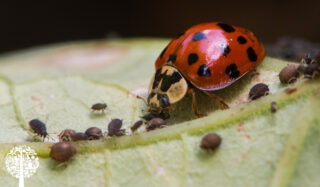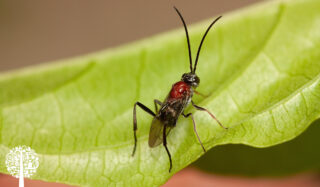
5 Beneficial Bugs To Look For In Your Garden
Bugs! Just the word itself has connotations of annoyance and intrusiveness. Not to mention that there’s an entire industry dedicated to destroying bugs on our grass and in our gardens. But that doesn’t mean that all bugs are bad. Some are even good for your garden and yard!
Ladybugs

Despite their name, Ladybugs aren’t very “ladylike.” Especially when it comes to their larval stage. Rather than sitting around drinking afternoon tea like the ladies of Downton Abbey, larval ladybugs attack and feed on aphids like the bad guys who killed her family in one of those kick-ass revenge movies. Aphids are sap-sucking insects that can kill your plants, and ladybug larvae can chow down on up to 40 of them every hour.
Dragonflies
Dragonflies lay their eggs near water, so if you don’t have waterfront property, you’ll want to install a little pond or fountain in your garden to attract them to the area. Then sit back and let them do their thing. Dragonflies eat flying pests – flies, mosquitos, moths, and midges. And with the ability to fly at speeds up to 35 mph and eat their weight in bugs every half hour, few will escape these beneficial predators.
Braconid Wasp

If you’re looking for a pollinator, stick to bees. While wasps pollinate, the lack of fuzzy legs makes them less efficient at this essential task. However, certain wasps can be helpful for things other than pollinating. As tomato gardeners know, the tomato hornworm is no friend to your bright red fruit. But you know who isn’t a friend to the tomato hornworm? That’s right, the braconid wasp.
Robber Flies
No one likes flies, and robbers aren’t something we want either. However, before you go swatting the robber flies away, allow me to illuminate how they can be positive in your garden. Robber flies, also known as assassin flies, get their name from being so aggressive in their predatory nature. And this is good for you because they put that predatory aggressiveness to use attacking other insects – many of which are garden pests. Also, unless threatened, they don’t attack humans.
Green Lacewing

Adult green Lacewings eat pollen and nectar, which isn’t beneficial to your garden. However, they also lay up to 200 eggs at a time, and those little guys are what you’re waiting for regarding benefits. From aphids and spider mites to whiteflies, thrips, grasshoppers, small caterpillars, and some beetles – green lacewing larvae eat them all. And they can consume up to 200 pests per week. Do the math: 200 larvae times 200 pests equals fewer destructive bugs in your garden every week. And they’re also commercially available for purchase at certain stores and online.
Similar Articles
LEAVE A COMMENT

- Jesse Singer
